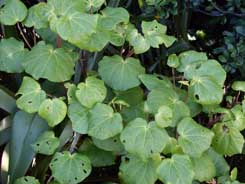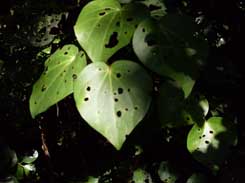Kawakawa: using oil and hydrosol
We are proud to announce that we have two new kawakawa products, a hydrosol and an infused oil.
Both have an exquisite aroma, and are lovely to be around!

Kawakawa (Macropiper excelsum) is a New Zealand native shrub or small tree which has family members around the Pacific.
Kawakawa grows throughout New Zealand. Its beautiful heart shaped leaves are very aromatic, and native looper moth caterpillars find them irresistible - you can see some holes in the leaves in the photo! As a defence against being chewed to bits, the kawakawa plant releases an oil that gives the leaves their medicinal value.
Kawakawa leaves contain up to 3.5% volatile oil, comprised mainly of myristicin (70%), an aromatic ether related to eugenol (a local anaesthetic found in clove oil). These aromatic volatile oils give a unique scent to the hydrosol and infused oil – it’s an uplifting and refreshing perfume, quite unlike anything else – distinctly New Zealand.
Kawakawa has a long history of traditional and modern use, both internally and externally. Here we will concentrate on the external applications. (Internally, it has been taken to help the body adapt to stress, to relieve digestive problems, to treat internal parasites, and as a blood purifier and diuretic. Kawakawa is also used to treat coughs, colds and bronchitis.)
 The hydrosol is a clear liquid, while the oil is made by infusing kawakawa in extra virgin olive oil.
The hydrosol is a clear liquid, while the oil is made by infusing kawakawa in extra virgin olive oil.Here are some ways of using the hydrosol:
Baby wipes: Being antibacterial and anti-inflammatory, the hydrosol is a wonderful base liquid for home-made baby wipes.
Skin conditions: Kawakawa hydrosol’s analgesic properties help to sooth a range of skin conditions, from neuralgia to some kinds of eczema.
Cuts, wounds, abrasions, boils & abscesses: An effective antimicrobial plant, Kawakawa is popular for treating injuries and wounds – great for cleaning kids’ scrapes and cuts.
As an insect repellant: Combine the hydrosol with a few drops of essential oils such as manuka, citronella, lavender and/or lemongrass.
Some ways of using the oil:
Baby nappy balm: Combine the oil with beeswax in a proportion of 85:15 – see the recipes on our website for more info.
Eczema: For dry eczema, make a barrier cream by combining the oil with beeswax.
Moisturiser for skin conditions: Add the oil to a high-quality unfragranced moisturising cream.
Circulatory stimulant: Rub the oil gently into the skin to improve circulation in conditions such as bruising, chilblains and Raynaud’s.
Aches and pains, arthritis: Add kawakawa oil to a high-quality unfragranced moisturizer, and rub this on aching joints.
Muscular cramps: Use as a massage oil.
 Kawakawa is a nice plant to become acquainted with. I have had a series of kawakawa plants as indoor pot plants – I love their shapely bright green leaves. When they get too big or spindly, I move them into the garden to join the other natives.
Kawakawa is a nice plant to become acquainted with. I have had a series of kawakawa plants as indoor pot plants – I love their shapely bright green leaves. When they get too big or spindly, I move them into the garden to join the other natives.When I read your Facebook posts, I realise I need to think of my kawakawa patch as a herb garden! Some of you have said that it's the holey leaves that have the most medicinal value - I guess those leaves are working hardest to repel the caterpillars!

Comments